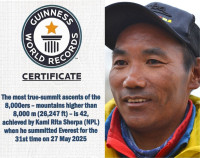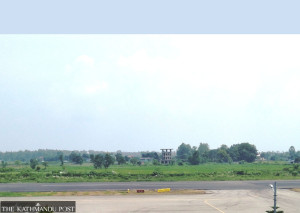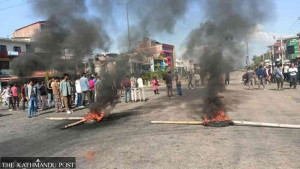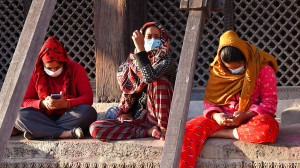National
Another pre-monsoon windstorm hits western Nepal, leaving two dead
Meteorologists say occurrence of windstorm and rainfall common during pre-monsoon
Chandan Kumar Mandal
Two people were killed and over a hundred injured as a raging windstorm tore through three districts in western Nepal—Kailali, Kanchanpur and Bardiya—on Thursday evening. Bir Bahadur Chaudhary and Lahun Chaudary of Majgaun in Godavari Municipality-1 were killed in the disaster.
The storm clocked a speed of a 95 kilometres per hour and lasted nearly two hours, according to the Meteorological Forecasting Division.
According to the preliminary report issued by the police, 79 people were injured in Kailali and 23 in Kanchanpur. Severely injured four were taken to hospitals in Nepalgunj and across the border in India. Twenty-eight are undergoing treatment at Seti Zonal Hospital, three of them in critical condition, according to Dr Jagadish Joshi, in-charge of the emergency unit at the hospital.
Trees and electricity poles were uprooted, disrupting power supply in the storm-hit areas. About 3,000 houses incurred damage in Kailali and 200 in Kanchanpur.
“Since the wind came so quick and all of a sudden, I was confused what to do, where to go,” Ram Singh Rawal, who is currently undergoing treatment at the Seti Zonal Hospital, said. Eighty-year-old Rawal has incurred injuries in his skull and body. He was rescued buried in the debris of his house. “As the wind intensified, I rushed to the main door, the roof made of zinc plates flew away, and the bricks in the walls started to fall,” Rawal said.
Windstorms have been frequent this pre-monsoon season. In May, another powerful windstorm cut through Bara and Parsa districts in Province 2, leaving at least 28 people dead, over 400 injured, and causing a massive damage of property and structures.
According to Shanti Kadel, a senior meteorologist with the forecast division, sudden and powerful windstorms coupled with heavy rainfall are common during the pre-monsoon season, which generally sees sunny afternoons and rainy evenings.
“However, the country, especially the southern plains, has witnessed unusually powerful and frequent windstorms,” Kadel told the Post. “After the Bara and Parsa disaster, there have been windstorms in places like Janakpur and elsewhere in the Tarai”
Kadel said that these extreme events do not appear to be connected as they are the results of local meteorological phenomena.
Thursday’s windstorm occurred not only because of the local wind. The destructive windstorm was generated after the ‘convergence’ of local wind, westerly wind and southeasterly wind from the Bay of Bengal that carried moisture.
The same windstorm had started moving towards the eastern part of the country later in the night. Kathmandu Valley witnessed strong winds and heavy rainfall on Friday morning, which was the result of the windstorm in western Nepal reaching the Capital.
According to the Meteorological Forecasting Division, the windstorm is likely to get weaker as it keeps moving eastward. The weather office has predicted that the eastern and central parts of the country will witness overcast conditions, whereas some places in western hills and a few places in central and eastern districts will receive light to moderate rainfall with thunderstorm until Sunday.
Country’s poor early warning system was exposed when an approaching powerful storm could not be predicted in May as the country did not have the required technology—the weather radar. The weather office said that relying on its limited resources, it could disseminate warning nearly two hours in advance.
“We did not predict the Bara and Parsa windstorm not because we did not want to but because we could not do so. If only we had weather radar, we could give longer hour updates on weather condition, wind speed and their movement, cloud formation and additional atmospheric information,” said Kadel.
The government has allocated budget for installing weather radars in Udayapur and Palpa, and announced a plan to operate such radar in Surkhet in the upcoming fiscal year.
With inputs from our local correspondents




 19.12°C Kathmandu
19.12°C Kathmandu













%20(1).jpg&w=300&height=200)

